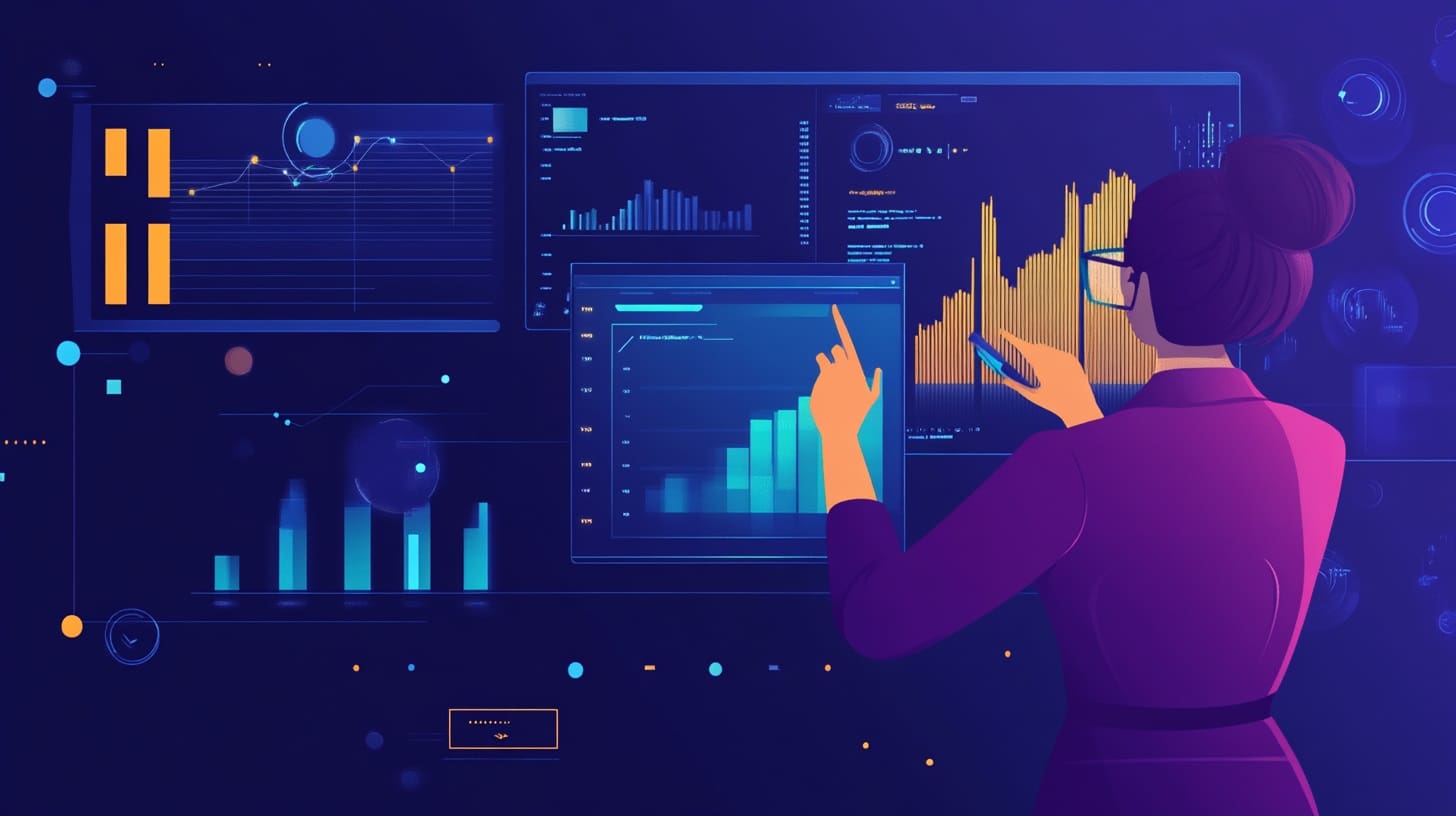In today’s fast-paced and data-driven world, the ability to analyze and interpret vast amounts of information has become a critical skill across various industries. This is where data science comes into play. Data science is not just a buzzword; it is a powerful field that combines statistics, mathematics, computer science, and domain expertise to extract meaningful insights from data. These insights drive decision-making, optimize processes, and even predict future trends, making data science an indispensable tool in the modern world.
Understanding Data Science
At its core, data science is the study of data. It involves collecting, cleaning, and analyzing data to uncover patterns, trends, and correlations that can inform decision-making. But data science goes beyond mere analysis. It includes the use of algorithms, machine learning models, and artificial intelligence to automate and enhance the process of data interpretation.
For beginners, it’s important to understand that data science is an interdisciplinary field. It draws upon knowledge from statistics for data analysis, computer science for data processing and algorithm development, and domain-specific expertise to ensure the insights are relevant and actionable. This combination allows data scientists to tackle complex problems and deliver solutions that are both innovative and practical.
The Importance of Data Science in Modern Society
Data science has rapidly evolved to become a cornerstone of modern society. As we generate more data every day—from social media interactions to online shopping behaviors and sensor data from the Internet of Things (IoT)—the need to understand and utilize this data effectively has grown exponentially.
Driving Business Decisions
In the business world, data science is critical for making informed decisions. Companies use data science to analyze customer behavior, optimize marketing strategies, and improve operational efficiency. For instance, e-commerce platforms like Amazon rely heavily on data science to recommend products to users based on their browsing history and purchasing patterns. This not only enhances the customer experience but also drives sales and boosts revenue.
Moreover, businesses leverage data science to forecast market trends, manage risks, and identify new opportunities. By analyzing historical data, companies can predict future outcomes and adjust their strategies accordingly. This predictive capability gives businesses a competitive edge in an increasingly data-driven market.
Enhancing Healthcare
Data science is revolutionizing the healthcare industry by enabling more personalized and efficient care. Healthcare providers use data science to analyze patient records, track the spread of diseases, and develop new treatment protocols. For example, machine learning algorithms can predict patient outcomes based on their medical history and suggest the most effective treatment plans.
In public health, data science helps track and predict the spread of infectious diseases. During the COVID-19 pandemic, data scientists played a crucial role in modeling the spread of the virus and informing public health policies. By analyzing data from various sources, they were able to provide insights that guided decision-making at both local and global levels.
Transforming Education
The education sector is also benefiting from data science. Educational institutions use data analytics to improve student outcomes, optimize course offerings, and enhance the learning experience. For instance, data science can identify students who are at risk of falling behind and provide targeted interventions to help them succeed.
Online learning platforms, such as Coursera and Khan Academy, use data science to personalize learning experiences. By analyzing how students interact with course materials, these platforms can recommend additional resources, adjust the difficulty of tasks, and even predict which concepts students might struggle with. This level of personalization makes learning more effective and engaging.
Optimizing Transportation
Transportation is another industry where data science plays a vital role. From optimizing routes to predicting maintenance needs, data science helps transportation companies operate more efficiently and safely. For example, ride-sharing services like Uber use data science to match drivers with passengers, minimize wait times, and optimize pricing based on demand.
In public transportation, data science is used to analyze traffic patterns, predict delays, and improve the overall efficiency of transportation networks. This helps cities reduce congestion, lower emissions, and provide better services to their residents.
Key Components of Data Science
To understand the role of data science in today’s world, it’s essential to grasp its key components. These components form the foundation of data science and are crucial for anyone looking to enter the field.
- Data Collection: The first step in any data science project is gathering data. This can involve collecting data from various sources, such as databases, APIs, or even manual entry. The quality and quantity of the data collected are critical, as they directly impact the analysis and insights that follow.
- Data Cleaning: Once the data is collected, it often needs to be cleaned and processed. This step involves removing errors, filling in missing values, and ensuring consistency across the dataset. Data cleaning is a crucial part of the process, as even the most sophisticated models can’t compensate for poor-quality data.
- Data Analysis: Data analysis involves exploring and interpreting the data to uncover patterns, trends, and relationships. This step often uses statistical methods and visualization techniques to make sense of the data. The goal is to identify meaningful insights that can inform decision-making.
- Machine Learning: Machine learning is a subset of data science that involves building models to predict outcomes based on data. These models can range from simple linear regressions to complex neural networks. Machine learning allows data scientists to automate analysis and make predictions with a high degree of accuracy.
- Data Visualization: Data visualization is the process of creating visual representations of the data, such as charts, graphs, and dashboards. Visualization helps communicate complex insights in an easily digestible format, making it easier for stakeholders to understand and act on the data.
- Data Interpretation: The final component of data science is interpreting the results and translating them into actionable insights. This step involves not only understanding the data but also communicating it effectively to non-technical stakeholders. The ability to interpret and present data in a clear and concise manner is a crucial skill for any data scientist.
The Growing Demand for Data Scientists
As the importance of data science continues to grow, so does the demand for skilled data scientists. Companies across all industries are seeking professionals who can analyze data, build predictive models, and drive data-driven decision-making. This demand is reflected in the increasing number of job opportunities in the field, as well as the competitive salaries offered to data scientists.
For beginners, this represents a significant opportunity. With the right skills and knowledge, you can enter a field that is not only in high demand but also offers the chance to work on exciting and impactful projects. Whether you’re interested in business, healthcare, education, or another industry, data science provides the tools and techniques needed to make a real difference.
The role of data science in today’s world is undeniably significant. From driving business decisions to transforming industries like healthcare, education, and transportation, data science is at the forefront of innovation. For beginners, understanding the fundamentals of data science and its applications is the first step toward entering this dynamic field. In the following sections, we will explore the tools, techniques, and practical steps needed to build a career in data science, providing you with the insights necessary to get started.
Essential Tools and Technologies in Data Science
As we delve deeper into the role of data science in today’s world, it’s important to understand the tools and technologies that data scientists use to perform their work. These tools enable professionals to handle the vast amounts of data they encounter, analyze it effectively, and derive meaningful insights. For beginners, getting acquainted with these tools is crucial as they form the backbone of most data science projects.
Programming Languages
Programming is a fundamental skill in data science, and several programming languages are commonly used in the field. These languages offer the flexibility and power required to manipulate data, implement algorithms, and create data models.
- Python: Python is the most popular programming language in data science due to its simplicity, readability, and extensive ecosystem of libraries. Libraries such as Pandas, NumPy, and SciPy are essential for data manipulation and analysis. Additionally, Python has powerful libraries like Matplotlib and Seaborn for data visualization, and Scikit-learn and TensorFlow for machine learning. Its versatility and ease of learning make Python an excellent starting point for beginners.
- R: R is another widely used language, particularly in academic and research settings. It is especially strong in statistical analysis and data visualization, with packages like ggplot2 and dplyr providing powerful tools for these tasks. R’s syntax is geared towards data analysis, making it a favorite among statisticians and data analysts.
- SQL: Structured Query Language (SQL) is essential for working with databases. SQL allows data scientists to retrieve, manipulate, and manage data stored in relational databases. Given that much of the data used in data science is stored in databases, proficiency in SQL is a must for any aspiring data scientist.
- Other Languages: While Python, R, and SQL are the most commonly used languages, others like Julia, Scala, and Java also play a role in data science, particularly in big data processing and performance-intensive tasks.
Data Manipulation and Analysis Tools
Beyond programming languages, data scientists rely on specific tools designed to simplify data manipulation and analysis. These tools help in cleaning, transforming, and preparing data for analysis.
- Pandas: Pandas is a Python library that provides data structures like DataFrames, which are essential for manipulating structured data. It allows for efficient filtering, grouping, and aggregation of data, making it a cornerstone of data manipulation in Python.
- NumPy: NumPy is another critical Python library, primarily used for numerical computing. It supports large, multi-dimensional arrays and matrices, and includes a collection of mathematical functions to operate on these arrays. NumPy is foundational for many other data science libraries.
- Jupyter Notebooks: Jupyter Notebooks offer an interactive environment for data scientists to write code, visualize data, and document their analysis. This tool is particularly useful for exploratory data analysis (EDA), allowing data scientists to iterate quickly and share their findings with others.
- Tableau: Tableau is a powerful data visualization tool that enables users to create interactive and shareable dashboards. It is user-friendly and doesn’t require advanced programming skills, making it accessible to beginners. Tableau is widely used in business environments for its ability to transform complex data into visual insights that are easy to understand.
- Excel: While Excel might seem basic, it remains a powerful tool for data analysis, especially in business contexts. Its ability to handle data manipulation, visualization, and even basic statistical analysis makes it a staple for many data scientists, particularly in the early stages of a project.
Machine Learning Frameworks
Machine learning is a critical component of data science, enabling data scientists to build models that can predict outcomes and uncover patterns in data. Several frameworks make it easier to implement these models.
- Scikit-learn: Scikit-learn is a Python library that provides simple and efficient tools for data mining and data analysis. It supports a wide range of supervised and unsupervised learning algorithms, making it a go-to tool for beginners in machine learning.
- TensorFlow: Developed by Google, TensorFlow is an open-source machine learning framework that is widely used for building and training deep learning models. TensorFlow’s scalability makes it suitable for both small-scale projects and large, complex models.
- Keras: Keras is a high-level neural networks API, written in Python and capable of running on top of TensorFlow. It allows for quick prototyping and experimentation, which is ideal for beginners who want to delve into deep learning.
- PyTorch: PyTorch, developed by Facebook’s AI Research lab, is another popular deep learning framework. Known for its flexibility and ease of use, PyTorch is favored in academic research and is increasingly being adopted in industry as well.
Big Data Tools
With the ever-increasing volume of data generated today, handling and processing large datasets—commonly referred to as “Big Data”—requires specialized tools and technologies.
- Apache Hadoop: Hadoop is an open-source framework that allows for the distributed storage and processing of large datasets. It uses a distributed file system that enables data to be stored across multiple servers, making it highly scalable and fault-tolerant.
- Apache Spark: Spark is another open-source big data processing framework, known for its speed and ease of use compared to Hadoop. Spark can process data in real-time and supports various programming languages, including Python, R, and Scala. It’s widely used in big data analytics for its ability to handle large-scale data processing with efficiency.
- NoSQL Databases: NoSQL databases like MongoDB and Cassandra are designed to handle unstructured data that doesn’t fit neatly into the tables of a relational database. These databases are crucial for dealing with big data, particularly in scenarios where the data structure can change over time.
Cloud Platforms
As data science operations increasingly move to the cloud, familiarity with cloud platforms is becoming essential. These platforms offer scalable resources for data storage, processing, and analysis, which are crucial for handling large datasets.
- Amazon Web Services (AWS): AWS provides a comprehensive suite of cloud computing services, including data storage (Amazon S3), big data processing (Amazon EMR), and machine learning (Amazon SageMaker). AWS is widely used by companies of all sizes for its flexibility and scalability.
- Microsoft Azure: Azure offers similar cloud services, including data storage, machine learning, and big data analytics. Azure’s integration with Microsoft products like Excel and Power BI makes it a popular choice for businesses already using Microsoft tools.
- Google Cloud Platform (GCP): GCP provides robust cloud services, including BigQuery for data warehousing and TensorFlow for machine learning. Google’s expertise in AI and machine learning is reflected in GCP’s powerful tools, making it a strong contender in the cloud computing space.
Practical Applications of Data Science Tools
Understanding the tools and technologies used in data science is crucial, but it’s equally important to see how these tools are applied in real-world scenarios. Data science tools are used across various industries to solve complex problems and drive innovation.
- Predictive Analytics: In retail, predictive analytics powered by data science tools helps businesses forecast demand, manage inventory, and personalize marketing efforts. By analyzing historical sales data, companies can predict future trends and adjust their strategies to meet customer needs more effectively.
- Fraud Detection: In finance, data science is used to detect fraudulent activities. Machine learning models analyze transaction data in real-time to identify patterns that indicate fraud, helping banks and financial institutions prevent losses and protect customers.
- Supply Chain Optimization: In manufacturing and logistics, data science tools help optimize supply chains by predicting demand, managing inventory levels, and minimizing delays. For example, companies like Amazon use data science to ensure that products are stocked in the right locations to meet customer demand efficiently.
- Customer Segmentation: In marketing, data science tools are used for customer segmentation. By analyzing customer data, businesses can identify different customer segments and tailor their marketing strategies to each group, increasing engagement and sales.
The tools and technologies discussed here are at the heart of modern data science. They empower data scientists to handle complex datasets, perform sophisticated analyses, and generate insights that drive decision-making across various industries. As you continue to explore data science, gaining proficiency in these tools will be essential. The next section will focus on the process of becoming a data scientist, including the skills you need to develop, the learning paths available, and the career opportunities in this rapidly growing field.
Becoming a Data Scientist: Skills, Learning Paths, and Career Opportunities
Having explored the essential tools and technologies in data science, the next logical step is to understand how to build a career in this dynamic and rapidly evolving field. Becoming a data scientist requires a combination of technical skills, domain knowledge, and a continuous learning mindset. This section will guide you through the key skills you need to develop, the learning paths you can follow, and the exciting career opportunities that await you in data science.
Essential Skills for Data Scientists
Data science is an interdisciplinary field, and becoming proficient requires a diverse set of skills. These skills are not only technical but also involve critical thinking, problem-solving, and communication. Here’s a breakdown of the core skills every aspiring data scientist should focus on:
- Programming Skills: Proficiency in programming languages like Python, R, and SQL is fundamental. These languages are used for data manipulation, analysis, and model building. Python, in particular, is highly versatile and widely used in the industry, making it a must-learn for beginners.
- Statistical Knowledge: A strong understanding of statistics is crucial in data science. This includes knowledge of probability, distributions, hypothesis testing, and regression analysis. Statistics form the basis for many data analysis techniques and machine learning algorithms.
- Data Wrangling: The ability to clean, transform, and preprocess data is essential. Real-world data is often messy and incomplete, and data scientists must be adept at handling missing values, outliers, and other data quality issues. Tools like Pandas in Python are invaluable for data wrangling.
- Machine Learning: Machine learning is at the heart of predictive modeling in data science. Understanding algorithms such as linear regression, decision trees, random forests, and neural networks is key. Familiarity with machine learning frameworks like Scikit-learn, TensorFlow, and PyTorch is also important.
- Data Visualization: Communicating data insights effectively requires strong data visualization skills. Tools like Matplotlib, Seaborn, and Tableau help in creating visual representations of data that are easy to understand and interpret. Good visualizations can make complex data accessible to non-technical stakeholders.
- Domain Knowledge: While technical skills are important, domain knowledge is what allows data scientists to apply their skills effectively in specific industries. Whether it’s finance, healthcare, marketing, or another field, understanding the domain helps in asking the right questions and interpreting data in a meaningful context.
- Critical Thinking and Problem-Solving: Data science involves tackling complex problems, often with incomplete information. Critical thinking and problem-solving skills enable data scientists to approach these challenges systematically, break down problems into manageable parts, and devise effective solutions.
- Communication Skills: Data scientists must be able to communicate their findings to both technical and non-technical audiences. This includes writing clear reports, presenting data visually, and explaining complex concepts in simple terms. Effective communication ensures that data-driven insights are understood and implemented by decision-makers.
Structured Learning Paths
Entering the field of data science can be daunting, but a structured learning path can make the journey more manageable. Whether you’re a complete beginner or looking to transition from another field, there are several educational routes you can take:
- Online Courses and MOOCs: Online learning platforms like Coursera, edX, and Udemy offer a wide range of courses tailored to different aspects of data science. Courses like “Introduction to Data Science in Python” by the University of Michigan on Coursera and “Data Science and Machine Learning Bootcamp with R” on Udemy are excellent starting points. These courses typically include video lectures, assignments, and hands-on projects.
- Bootcamps: Data science bootcamps are intensive, short-term programs designed to equip you with practical skills in a relatively short period. Bootcamps like General Assembly, Springboard, and DataCamp focus on real-world applications, often culminating in a capstone project that you can showcase in your portfolio. Bootcamps are a great option if you’re looking to make a quick transition into data science.
- University Degrees: For those who prefer a more traditional educational path, pursuing a degree in data science, computer science, or a related field is a solid option. Many universities now offer specialized data science programs at the undergraduate and graduate levels. These programs provide a comprehensive education in the theoretical and practical aspects of data science.
- Self-Learning and Practice: Data science is a field where self-learning is highly valued. Many successful data scientists are self-taught, relying on books, online resources, and personal projects to build their skills. Books like “Python for Data Analysis” by Wes McKinney and “R for Data Science” by Hadley Wickham are great resources. Participating in data science competitions on platforms like Kaggle or contributing to open-source projects on GitHub can also help you gain practical experience.
Building a Portfolio
In data science, a portfolio of projects is often more valuable than a resume. A well-curated portfolio demonstrates your ability to apply data science techniques to real-world problems. Here’s how to build a strong portfolio:
- Personal Projects: Start with projects that interest you. Whether it’s analyzing a public dataset, building a predictive model, or creating a data visualization, personal projects allow you to explore different aspects of data science while building your skills. Make sure to document your process and results clearly.
- Kaggle Competitions: Kaggle offers a platform for data science competitions where you can work on real-world problems. Participating in these competitions not only helps you hone your skills but also allows you to compare your solutions with those of other data scientists. Even if you don’t win, participating in Kaggle competitions can provide valuable experience and content for your portfolio.
- Open-Source Contributions: Contributing to open-source data science projects on platforms like GitHub is another excellent way to build your portfolio. Open-source contributions demonstrate your ability to work collaboratively on complex projects and show that you’re engaged with the data science community.
- Blogging and Presentations: Writing blog posts or giving presentations on your data science projects can further enhance your portfolio. Explaining your work in a clear and accessible way demonstrates your communication skills, which are crucial in data science. Platforms like Medium or personal websites can be great places to share your insights.
Career Opportunities in Data Science
The demand for data scientists is growing rapidly across industries, making it one of the most sought-after careers today. Here are some of the roles you can pursue within the field of data science:
- Data Scientist: The role of a data scientist involves collecting, analyzing, and interpreting complex data to help organizations make informed decisions. Data scientists use their expertise in statistics, machine learning, and domain knowledge to solve challenging problems and uncover insights.
- Data Analyst: Data analysts focus on interpreting data and generating reports that provide insights into specific aspects of a business. They often work with structured data and use tools like Excel, SQL, and Tableau to create visualizations and dashboards.
- Machine Learning Engineer: Machine learning engineers specialize in designing and implementing machine learning models. They work closely with data scientists to develop algorithms that can learn from and make predictions on data. This role often requires strong programming skills and a deep understanding of machine learning frameworks.
- Data Engineer: Data engineers are responsible for designing, building, and maintaining the infrastructure that allows data scientists to analyze data. They work with large-scale data processing systems and ensure that data pipelines are robust, scalable, and efficient.
- Business Intelligence Analyst: Business intelligence (BI) analysts focus on analyzing data to help organizations make strategic decisions. They often use BI tools to create dashboards and reports that summarize key business metrics, providing insights that drive decision-making.
- AI Researcher: AI researchers work on advancing the field of artificial intelligence through research and development. They explore new algorithms, develop novel machine learning techniques, and often publish their findings in academic journals. This role is more research-oriented and may require a strong background in mathematics and computer science.
Building a career in data science is an exciting journey that offers numerous opportunities to make a significant impact across various industries. By developing the right skills, following a structured learning path, and building a strong portfolio, you can position yourself for success in this rapidly growing field. Whether you aspire to become a data scientist, machine learning engineer, or data analyst, the demand for data science professionals is only expected to increase, making it a promising career choice for years to come.








